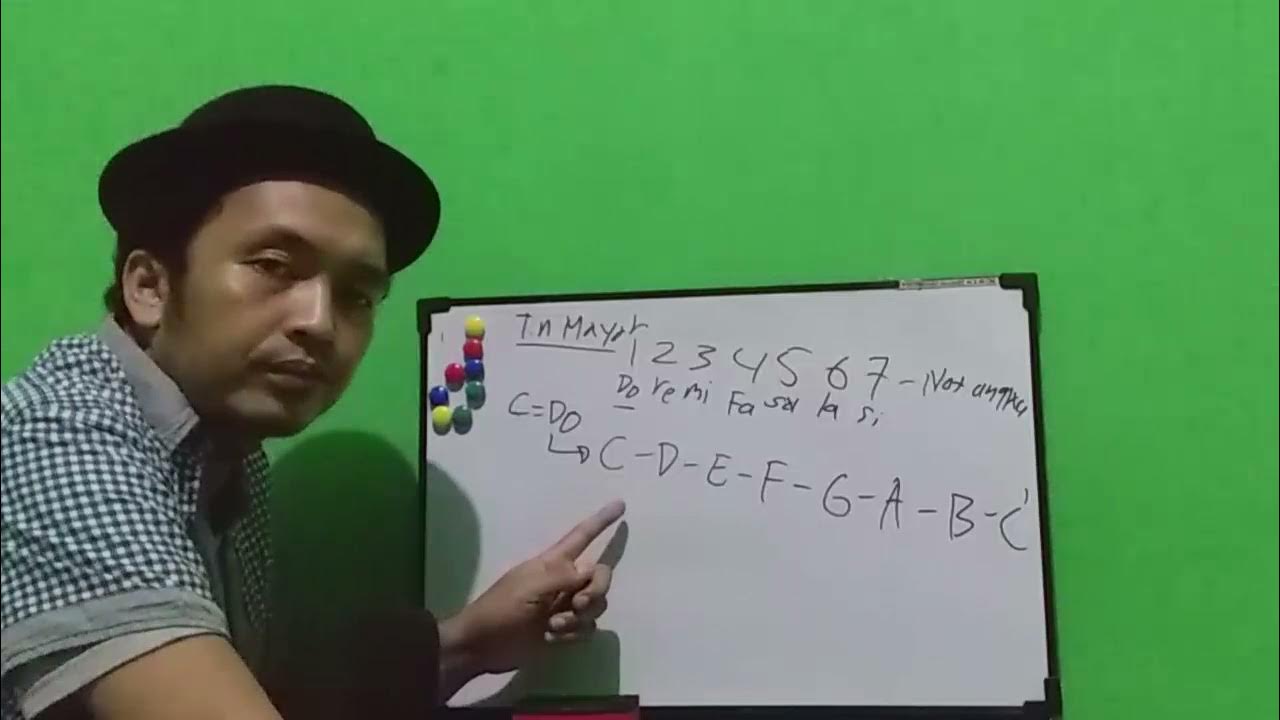TANGGA NADA MAYOR [PART 1] | SESSION PLAYER, MERAPAATT !!
Summary
TLDRIn this informative video, the host Icang from Channel Musik Academia introduces viewers to the concept of musical scales, focusing on the major scale. He explains the basic structure of the diatonic scale, starting with the C major scale and detailing the intervals between notes. Icang also discusses the use of accidentals like sharps and flats to alter notes and create different scales. The video aims to educate and guide music enthusiasts on understanding and constructing major scales, with a promise to cover minor scales in a subsequent video.
Takeaways
- 🎵 The video is a part of the 'Channel Musik Akademi', which discusses tips, tutorials, and information about music.
- 📢 The host, Icang, thanks the audience for subscribing, liking, commenting, sharing, and turning on notifications for the channel.
- 👋 A warm welcome is extended to new subscribers and viewers, with a reminder to engage with the content and enable notifications.
- 🎶 The main topic of the video is the musical scale, specifically focusing on the major scale before potentially covering the minor scale in a future video.
- 📝 The script defines a musical scale as an alphabetical arrangement of notes, starting from the lowest to the highest or vice versa.
- 🔠 The major scale is introduced with the example of C major (C = Do), explaining the intervals between the notes C, D, E, F, G, A, B, and back to C.
- 📐 The intervals of the major scale are described as 'whole steps' and 'half steps', with specific mention of the pattern 'whole, whole, half, whole, whole, whole, half'.
- 🎼 The concept of 'tanda alterasi' or 'accidentals' is introduced, explaining 'sharp' and 'flat' symbols that adjust the pitch of a note.
- 🛠️ The process of constructing a new scale is discussed, emphasizing the use of the fifth note from an existing scale to begin a new one.
- 🔄 The video corrects a common misconception about the piano's 'do-re-mi-fa-so-la-ti-do' and explains the proper intervals and construction of scales.
- 📝 The script provides a step-by-step guide on how to identify and correct intervals in the scale, ensuring they match the pattern of a major scale.
- 🔚 The video concludes with a reminder to like, comment, and subscribe for more updates, and ends with a traditional greeting and applause.
Q & A
What is the main topic of the video?
-The main topic of the video is about the diatonic scale, specifically focusing on the major scale (tangan ada mayor).
What does 'tangan ada' refer to in the context of the video?
-'Tangan ada' in the video refers to the diatonic scale, which is a sequence of notes arranged in alphabetical order from the lowest to the highest note, or vice versa.
What are the two types of diatonic scales mentioned in the video?
-The two types of diatonic scales mentioned are the major scale (tangan ada mayor) and the minor scale (tangan ada minor).
What is the significance of the intervals in the major scale?
-The intervals in the major scale are the pattern of distances between the notes, which are crucial for constructing the scale and ensuring it follows the correct 'whole and half steps' pattern.
What is the basic pattern of intervals for a major scale?
-The basic pattern of intervals for a major scale is 'whole, whole, half, whole, whole, whole, half', which can be remembered as 'W-W-H-W-W-W-H'.
What is the concept of 'tanda alterasi' in the context of the scale?
-'tanda alterasi' refers to the accidentals in music, which are symbols that raise (sharp) or lower (flat) a note by a half step.
What is the difference between 'sharp' and 'flat' in music?
-In music, 'sharp' raises a note by a half step, while 'flat' lowers a note by a half step. They are represented by the symbols '#' for sharp and 'b' for flat.
How does the video explain constructing a new scale using the fifth note of an existing scale?
-The video explains that to construct a new scale, one should use the fifth note of the existing scale as the first note of the new scale and then follow the interval pattern of the major scale.
What is the purpose of the 'tanda kres' and 'tanda mol' in the scale?
-'tanda kres' (sharp) and 'tanda mol' (flat) are used to adjust the notes in the scale to fit the pattern of intervals for a major or minor scale, respectively.
What is the significance of the 'whole step' and 'half step' in the context of the major scale construction?
-The 'whole step' and 'half step' are the intervals between the notes in the scale. The correct sequence of these intervals is essential for maintaining the structure and sound characteristic of the major scale.
Why might the video creator disagree with the labeling of a musical instrument for beginners?
-The video creator might disagree because the labeling might incorrectly imply that all notes are 'do' or 'C', which could be misleading for beginners learning about different scales and the concept of 'tanda alterasi'.
What is the final message the video creator gives to the viewers?
-The final message is a reminder for viewers to like, comment, subscribe, and turn on notifications to get the latest videos, and a thank you note with a blessing in Arabic.
Outlines

此内容仅限付费用户访问。 请升级后访问。
立即升级Mindmap

此内容仅限付费用户访问。 请升级后访问。
立即升级Keywords

此内容仅限付费用户访问。 请升级后访问。
立即升级Highlights

此内容仅限付费用户访问。 请升级后访问。
立即升级Transcripts

此内容仅限付费用户访问。 请升级后访问。
立即升级浏览更多相关视频

Tangga Nada Diatonis Mayor dan Minor

Curso de Teoria Musical - Aula 03: Campo Harmônico l Aula #44

Curso de Teoria Musical - Aula 02: As Escalas e a Escala Maior l Aula #40

Cara Mencari Tangga Nada Mayor berdasarkan Interval atau jarak Nada

music theory is easy.

MUSIC 6 QUARTER 2 WEEK 1-2 | THE MAJOR SCALES
5.0 / 5 (0 votes)
